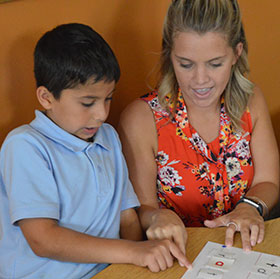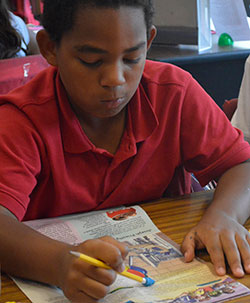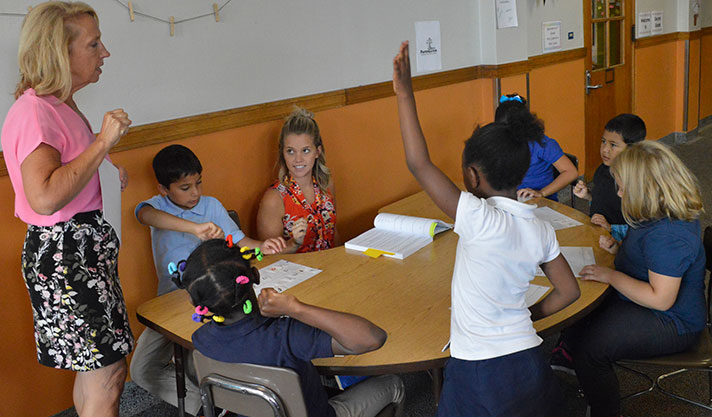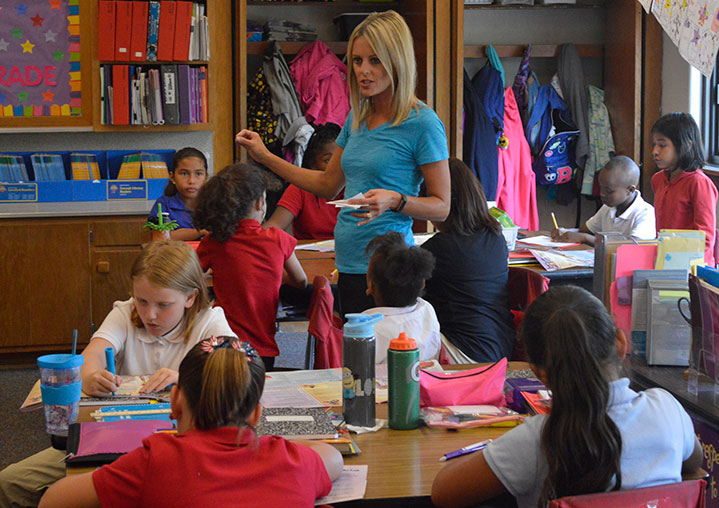Rebecca Ophoff’s 25 fourth-graders are following along an article at their desks as she asks them what kind of writing it is.
“What makes it expository? How do you know?” the Stocking School teacher asks. “Kylee?”
Kylee stands and offers, “Because the picture looks like he’s making something?,” referring to a picture of a man holding a plate of spaghetti with a pot boiling nearby.
“I tell you what, I’ve got to disagree,” Ophoff respectfully responds. “By looking at that picture, I would guess that this is a literary piece.”

She prods the class further, asking what other features might suggest expository writing. A girl named Kiarra stands and volunteers, “The reading. It says ‘Physical Changes.’”
She’s referring to a subhead of the story, which is about how matter changes form using boiling spaghetti as an example. The students are learning about science, but also how to differentiate forms of writing by looking for literary clues.
It’s a peek into how teachers at Stocking, a high-poverty neighborhood school, are using a cross-discipline approach to improve reading, while teaching other subject content. That may be one reason it was among a handful in Grand Rapids Public Schools that improved in all four subject areas of the M-STEP statewide assessment given last spring, leaders say.
“We’re really committed in this building to making sure that we’re teaching science and social studies throughout the day, so they have that knowledge base to draw from when they start to read at higher levels,” said Principal Joann Riemersma. “That’s a huge shift we’ve made here.”
Related Story: ‘Basics of Life for Some Kids Are Not Basic”
| Stocking School Snapshot Students: About 300, K-5 Race/ethnicity: About 30 percent each African-American, Hispanic and white; 10 percent refugee and other Free and reduced lunch: 96 percent of studentsM-STEP proficiency scores (percent of students proficient): |
|||
| 2017 | 2016 | All GRPS Schools, 2017 | |
| English Language Arts | 32% | 26% | 26% |
| Math | 32% | 21% | 17% |
| Science | 14% | 4% | 10% |
| Social Studies | 27% | 26% | 15% |
Poverty, Language Pose Challenges
To be sure, Stocking’s M-STEP reading score of 32 percent proficiency is modest compared with that of many other districts – although it is higher than the district-wide level and schools statewide generally had low reading scores. But the achievement gains of Stocking’s students in recent years are encouraging, at a school where nearly all students qualify for free or reduced lunch and many families struggle to pay the bills.
At Stocking, families face many of the same challenges as at other high-poverty districts such as Godfrey-Lee, where achievement levels largely reflect family income (see related story). Nationally, 80 percent of low-income fourth-graders were not proficient in reading, found a 2014 study by the Annie E. Casey Foundation.
Moreover, about one-third of Stocking’s students speak English as a second language, including refugees and immigrants from Latin America, Africa and the Middle East.
“They don’t have the experience some of our suburban kids have around science, the social world and the natural,” Riemersma said. “So we’ve got to provide lots and lots of opportunities for learning.”
By devoting more teaching time to science and social studies, Stocking’s M-STEP scores in those subjects have improved. But that also improves reading because students bring more “background knowledge” to what they read, Riemersma said. Storybook reading, though still taught, has been reduced in favor of reading academic-rich text, she said.
“We know how to tell a story. We know that structure. But we don’t know how to take a problem-solution piece and make sense of it. I don’t think it’s a reading issue,” said Riemersma, who has been a teacher and reading coach in GRPS. “It’s an understanding of concept issue.”
She calls it “reading with a purpose” – students gaining applicable knowledge from what they read. She cites an example by the cultural literacy scholar E.D. Hirsch Jr.: If you’re taking a test on baseball, you learn about balls and strikes, not reading strategies.

Strategies for Better Readers
Stocking’s approach is largely in keeping with all of GRPS, which has increased its emphasis on science and social studies. Because the old MEAP tests stressed math and reading, many districts inadvertently placed more emphasis on those areas to the neglect of other subjects – GRPS included, said Ron Gorman, assistant superintendent of pre-K-12 instructional support.
“We still feel like literacy is the most important thing,” Gorman said. “But those other areas are important as well. Our students deserve a quality education.”
That said, Gorman acknowledged the district needs to improve its reading scores, especially with the state’s new third-grade reading law taking effect in 2019-20. Just 23 percent of all GRPS third-graders scored proficient on the M-STEP reading portion.
The district is tackling the problem with several strategies: individual reading plans for all students achieving under the 60th percentile nationally for their grade level; extra instruction for students who need more help; home reading plans with assistance for parents; and closely following each student’s progress.
“We need to do a better job at monitoring where each student is,” Gorman said. “That’s not always easy when you have 25 students in a class.”
In Rebecca Ophoff’s class, that includes students whose first language is Swahili, Spanish and Arabic. Stocking’s English-language learners are pulled out of class three times a week for small-group instruction. On a recent morning, student teacher Megan Porter worked with six students in the hallway, helping them learn letters by having them place them on paper in the right order.
“All right, the next word I’m going to give you is ‘dad,’” Porter said, pointing to the letters on a board. “Take those letters and sound them out.”

A Total Team Approach
Although it specializes in science, technology, engineering and math (STEM), the school throws a lot of extra resources into helping students with reading.
Three Grand Valley State University classes meet there, and their students work with Stocking pupils. A staff member of The Education Trust-Midwest, a nonprofit advocacy group, is onsite to coach teachers. Staff are also supported by Teaching Works, a University of Michigan program, and some have taken training by Project Lead the Way. Community volunteers tutor students, and parents are coached on how to help their children read the bags of books they bring home.
All partnerships complement a building-wide approach used by “an extraordinary group of teachers,” said Riemersma, who led the program revamping after arriving in 2013. “Everybody who’s going to teach in this building knows that if you’re not ready to be part of this system, don’t come to Stocking School.”
As for the third-grade reading law, she admits it’s a “huge worry,” noting just 38 percent of last year’s third-graders were proficient (only 44 percent were statewide). But she and her staff are working hard to prepare students for when the law takes effect in two years: 90 percent of their kindergartners have individual reading plans.
“I don’t want to see anyone retained,” she said. “Now is the time to intervene.”
CONNECT
National Study on Gaps in Fourth-Grade Reading Proficiency
For Most Students, Achievement Reflects Income










